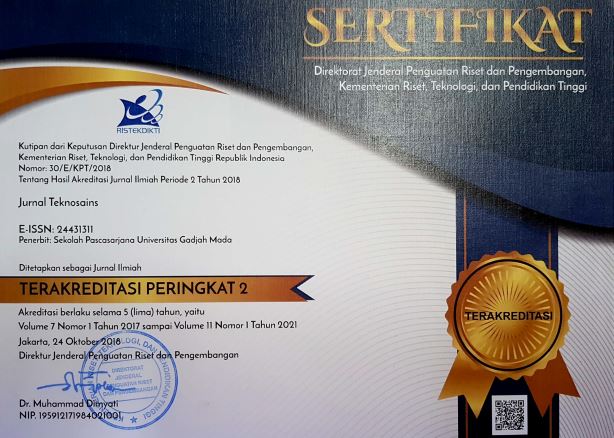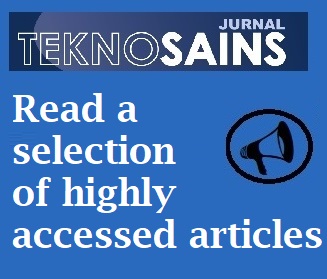Efektivitas sistem gabungan penukar kalor-udara tanah dengan kolektor surya untuk pendinginan ruangan di kota Medan
Tulus Burhanuddin Sitorus(1*), Syahrul Abda(2)
(1) Fakultas Teknik, Universitas Sumatera Utara; Pusat Energi Berkelanjutan dan Biomaterial, Universitas Sumatera Utara
(2) Fakultas Teknik, Universitas Sumatera Utara
(*) Corresponding Author
Abstract
Energy is one of the main things in a country's economic growth, but saving energy is one of the main challenges in the world today. In developing countries such as Indonesia, the energy sector is considered a crucial sector, because consumption demand increases compared to production. Therefore, to reduce energy consumption it is necessary to save energy. Earth-air heat exchanger cooling systems are one of them. The research objective was to determine the effectiveness performance of the EAHE system on changes in room temperature according to weather conditions in Medan city. The implication of this research is to reduce the consumption of electricity or fuel oil and environmental pollution. The test room has dimensions of 200 cm x 200 cm x 200 cm. Testing using a flat plate type solar collector to help the process of air movement by taking advantage of differences in air temperature. The testing process starts at 08.00 WIB to 17.00 WIB for nine hours everyday. The measurement results show that various weather conditions include radiation intensity, ambient temperature and humidity. During the test, the radiation intensity ranged from 38.10-892.12 W/m2, the variation in ambient temperature from 24.65-35.29oC and the average air humidity 68.93%. The experimental data showed that the fluctuation of indoor air temperature ranged from 23.01 to 31.84oC and the average room temperature 27.83oC. This study resulted in an average effectiveness value of the EAHE system of 51.49%. According to the result of the statistical studies, the weather conditionsthe effectiveness of the EAHE system by51,56%.
Keywords
Full Text:
PDFReferences
Agrawal, K. K., Agrawal, G. Das, Misra, R., Bhardwaj, M., & Jamuwa, D. K. (2018). A review on effect of geometrical, flow and soil properties on the performance of Earth air tunnel heat exchanger. Energy and Buildings, 176, 120–138. https://doi.org/10.1016/j.enbuild.2018.07.035
ASHRAE. (2013). Thermal environmental conditions for human occupancy. Dalam ASHRAE Standard. Diakses dari https://www.ashrae.org/technical-resources/bookstore/thermal-environmental-conditions-for-human-occupancy
Bordoloi, N., Sharma, A., Nautiyal, H., & Goel, V. (2018). An intense review on the latest advancements of Earth Air Heat Exchangers. Renewable and Sustainable Energy Reviews, 89, 261–280. https://doi.org/10.1016/j.rser.2018.03.056
Brum, R. S., Ramalho, J. V. A., Rodrigues, M. K., Rocha, L. A. O., Isoldi, L. A., & Dos Santos, E. D. (2019). Design evaluation of Earth-Air Heat Exchangers with multiple ducts. Renewable Energy, 135, 1371–1385. https://doi.org/10.1016/j.renene.2018.09.063
Chaturvedi Ashish Kumar, & Bartaria, V. N. (2015). Performance of Earth Tube Heat Exchanger Cooling of Air — a Review. International Journal of Mechanical Engineering and Robotics Research, 4(1), 378.
Chiesa, G. (2017). Climate-potential of earth-to-air heat exchangers. Energy Procedia, 122, 517–522. https://doi.org/10.1016/j.egypro.2017.07.300
Cuny, M., Lin, J., Siroux, M., Magnenet, V., & Fond, C. (2018). Influence of coating soil types on the energy of earth-air heat exchanger. Energy and Buildings, 158, 1000–1012. https://doi.org/10.1016/j.enbuild.2017.10.048
Duffie, J. A., Beckman, W. A., & McGowan, J. (1985). Solar Engineering of Thermal Processes. American Journal of Physics, 53(4):382. https://doi.org/10.1119/1.14178
Estrada, E., Labat, M., Lorente, S., & Rocha, L. A. O. (2018). The impact of latent heat exchanges on the design of earth air heat exchangers. Applied Thermal Engineering, 129, 306–317. https://doi.org/10.1016/j.applthermaleng.2017.10.007
Industries Daikin. (2015). Industries Daikin Business situations during the summer in Tokyo. Daikin 21st Surv Attitudes Mod People Towar Air.
Li, Haorong, Yu, Y., Niu, F., Shafik, M., & Chen, B. (2014). Performance of a coupled cooling system with earth-to-air heat exchanger and solar chimney. Renewable Energy, 62, 468–477. https://doi.org/10.1016/j.renene.2013.08.008
Li, Hui, Ni, L., Yao, Y., & Sun, C. (2019). Experimental investigation on the cooling performance of an Earth to Air Heat Exchanger (EAHE) equipped with an irrigation system to adjust soil moisture. Energy and Buildings, 196, 280–292. https://doi.org/10.1016/j.enbuild.2019.05.007
Maerefat, M., & Haghighi, A. P. (2010). Passive cooling of buildings by using integrated earth to air heat exchanger and solar chimney. Renewable Energy, 35(10), 2316–2324. https://doi.org/10.1016/j.renene.2010.03.003
Ozgener, L. (2011). A review on the experimental and analytical analysis of earth to air heat exchanger (EAHE) systems in Turkey. Renewable and Sustainable Energy Reviews, 15(9), 4483–4490. https://doi.org/10.1016/j.rser.2011.07.103
Sitorus, T. B. (2018). Kinerja Kolektor Tipe Plat Datar Pada Mesin Pendingin Adsorpsi Tenaga Surya Di Kota Medan. Jurnal Teknosains, 7(2), 94-103. https://doi.org/10.22146/teknosains.35327
Sitorus, T. B., & Abda, S. (2020). Performansi Kolektor Surya Pada Mesin Pendingin Yang Menggunakan Pasangan Adsorpsi Karbon Aktif Serbuk-Metanol. Teknik, 41(1), 1–8. https://doi.org/10.14710/teknik.v41i1.25406
Sitorus, T. B., Napitupulu, F. H., & Ambarita, H. (2016). Experimental study of solar refrigerator system using activated alumina and methanol adsorption pair. International Journal of Technology, 7(5), 910–922. https://doi.org/10.14716/ijtech.v7i5.1484
Soni, S. K., Pandey, M., & Bartaria, V. N. (2015). Ground coupled heat exchangers: A review and applications. Renewable and Sustainable Energy Reviews, 47, 83–92. https://doi.org/10.1016/j.rser.2015.03.014
Standar Nasional Indonesia. (2001). Tata Cara Perancangan Sistem Ventilasi dan Pengkondisian Udara pada Bangunan Gedung. In Sni 03 - 6572 - 2001.
Wang, X., Bjerg, B. S., & Zhang, G. (2018). Design-oriented modelling on cooling performance of the earth-air heat exchanger for livestock housing. Computers and Electronics in Agriculture, 152, 51–58. https://doi.org/10.1016/j.compag.2018.07.006
Article Metrics
Refbacks
- There are currently no refbacks.
Copyright (c) 2022 Tulus Burhanuddin Sitorus, Syahrul Abda

This work is licensed under a Creative Commons Attribution-ShareAlike 4.0 International License.
Copyright © 2024 Jurnal Teknosains Submit an Article Tracking Your Submission
Editorial Policies Publishing System Copyright Notice Site Map Journal History Visitor Statistics Abstracting & Indexing









